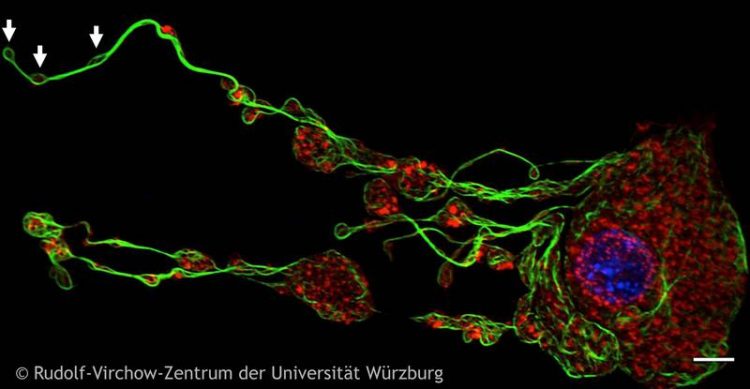Targeting platelets

Emerging platelets (white arrows) are buded off by their progenitor cells, the megakaryocytes. Here the cytoskeletal components tubulin (green) and actin (red) and the nucleus (blue) are colored. Rudolf Virchow Center of the Julius-Maximilians-Universität Würzburg
“Thrombocytes do much more than to stop bleedings and to cause heart attacks,” explains Professor Bernhard Nieswandt, Director of the Institute for Experimental Biomedicine, supported by the University Hospital Würzburg (UKW) and the Rudolf Virchow Center for Experimental Biomedicine of the Julius-Maximilians-Universität Würzburg (JMU), Germany.
“Recent studies have suggested that there are very complex interactions between the smallest blood cells and various inflammatory processes, cellular defense mechanisms, innate immunity, the maintenance of vascular and organ functions and the development of tumors.” According to Professor Nieswandt a more detailed knowledge of the underlying molecular mechanisms is central to a better understanding of diseases such as stroke and acute respiratory failure.
In collaboration with the University of Tübingen, Germany
The outstanding importance of platelet research was also confirmed by the DFG (Deutsche Forschungsgemeinschaft): They recently approved the Collaborative Research Center Transregio (SFB / TR 240) “Thrombocytes – molecular, cellular and systemic functions under physiological and pathological conditions”. The SFB TR 240 is funded with 13.7 million euros, for an initial term of four years, starting on July 1, 2018.
The Würzburg Institute for Experimental Biomedicine was leading the application. Prof. Dr. med. Meinrad Gawaz, Director of the Medical Clinic III (Cardiology) of the University of Tübingen, was co-applicant. Both institutions have longstanding research programs on platelets.
From bench to bedside: Basic research, but close to clinical application
“The very pronounced translational character that unites basic researchers with clinicians is one special strength of our network”, emphasizes Professor Nieswandt and specifies: “We are positive that our newly gained basic findings will quickly lead to novel treatment concepts for a whole series of Diseases that have not previously been seen in the context of platelets. “
Prof. Dr. med. Georg Ertl, Medical Director of the UKW, says proudly with regard to the reputation of the location: “The DFG reviewers confirmed with this grant approval that Professor Nieswandt and his team are among the world elite in fundamental platelet research. Research for our patients is one of our outstanding duties.”
Scientists from the Greifswald University Hospital and the Dortmund Leibniz Institute for Analytical Sciences (ISAS) are also involved in the new Collaborative Research Center. The interdisciplinary research group combines molecular genetics, in vivo disease models, high resolution microscopy, in vivo imaging, systems biology, translational approaches and clinical research.
Scientific Background
Each day, around 100 billion platelets are produced from giant progenitor cells in the bone marrow of a healthy person, circulating in the bloodstream for about ten days. Their best-described function is to control the vessel wall for injury, sealing it if necessary in order to prevent uncontrolled blood loss. If uncontrolled thrombus formation occurs, platelets can form large aggregates, big enough to lead to life-threatening vascular occlusions such as in the case of a heart attack or stroke.
Person
Since the year 2002 Professor Nieswandt works in various capacities at the JMU. After studying biology and biochemistry, he completed his doctorate at the University of Regensburg and habilitated in the field of experimental medicine at the University of Witten / Herdecke, Germany. Since 2008, he has held the Chair of Experimental Biomedicine with focus on Vascular Biology and is Head of the Institute for Experimental Biomedicine, which is jointly supported by the University Hospital Würzburg (UKW) and the Rudolf Virchow Center for Experimental Biomedicine at the JMU. Since April 2016, he is part of the dual leadership of the Rudolf Virchow Center for Experimental Biomedicine.
Further information on the Nieswandt research group on the Rudolf Virchow Center website under Research: www.rudolf-virchow-zentrum.de/forschung/arbeitsgruppen/ag-nieswandt/forschung.html
Prof. Dr. Bernhard Nieswandt (Chair of Experimental Biomedicine with focus on Vascular Biology, Rudolf Virchow Center)
Tel. +49 (0)9 31/ 31 – 80405, bernhard.nieswandt@virchow.uni-wuerzburg.de
Susanne Just (Stabsstelle Kommunikation, Universitätsklinikum Würzburg
)
Tel. +49 (0)931 / 201-59447, presse@ukw.de
Dr. Daniela Diefenbacher (Press Office, Rudolf Virchow Center)
Tel. +49 (0)931 3188631, daniela.diefenbacher@uni-wuerzburg.de
http://www.rudolf-virchow-zentrum.de/en/news/news/article/blutplaettchen-im-visi…
Media Contact
All latest news from the category: Life Sciences and Chemistry
Articles and reports from the Life Sciences and chemistry area deal with applied and basic research into modern biology, chemistry and human medicine.
Valuable information can be found on a range of life sciences fields including bacteriology, biochemistry, bionics, bioinformatics, biophysics, biotechnology, genetics, geobotany, human biology, marine biology, microbiology, molecular biology, cellular biology, zoology, bioinorganic chemistry, microchemistry and environmental chemistry.
Newest articles

A universal framework for spatial biology
SpatialData is a freely accessible tool to unify and integrate data from different omics technologies accounting for spatial information, which can provide holistic insights into health and disease. Biological processes…

How complex biological processes arise
A $20 million grant from the U.S. National Science Foundation (NSF) will support the establishment and operation of the National Synthesis Center for Emergence in the Molecular and Cellular Sciences (NCEMS) at…

Airborne single-photon lidar system achieves high-resolution 3D imaging
Compact, low-power system opens doors for photon-efficient drone and satellite-based environmental monitoring and mapping. Researchers have developed a compact and lightweight single-photon airborne lidar system that can acquire high-resolution 3D…





















